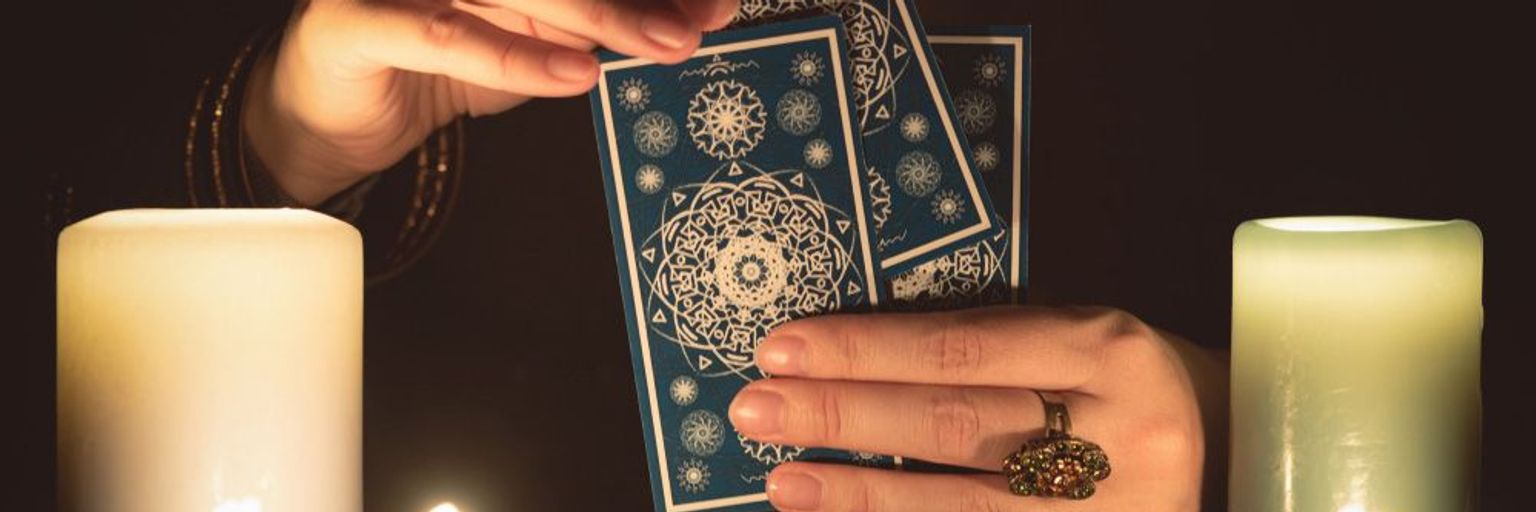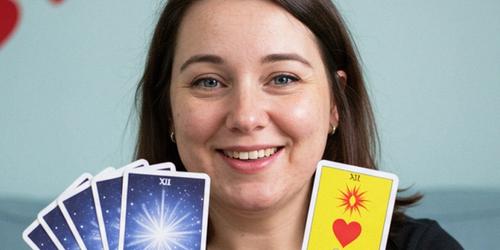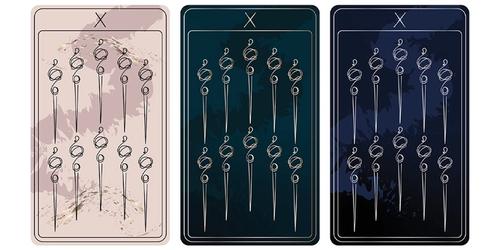
To pay for your reading on your telephone bill, simply call
Instantly message our featured psychics online via psychic messenger.
Click to start
Register now to start your reading online. PSYCHIC MESSENGER- Cheapest psychic service in the UK
- Our readers are available 24/7
- 100% confidential service
- In-depth, concise, personal readings
- Thousands of 5* reviews
Published 12/06/2023 by Joanne Jones
What Is a Tarot Reading?
A tarot reading is a divination practice using a tarot card deck. Tarot cards have been used worldwide for centuries, and their symbolic imagery has fascinated and intrigued people.
Tarot card decks have 78 cards, the major arcana comprising 22 cards and the minor arcana comprising 56 cards, divided into four suits - cups, swords, pentacles, and wands.
Each card has a unique pictorial representation and symbolic meaning that a card reader can interpret in different ways.
Tarot cards have been used for divination, meditation, and self-discovery and have become a popular tool for spiritual guidance. Each card can have multiple meanings, depending on the individual, and their interpretation can be influenced by the reader's intuition and understanding of the cards.
The interpretation of the cards during a reading is based on the reader's intuition, knowledge of the card's meanings, and the client's unique situation and energy.
While the cards themselves do not have any inherent power or wisdom, they can be used as a tool for connecting with the subconscious mind and gaining a deeper understanding of oneself and the world around us.
What Is a Tarot Reading?
Tarot readings can help people understand their emotions, relationships, career, spiritual growth, and personal development.
Intuitive readings can also provide guidance on important decisions, such as starting a new career or moving to a new place. Tarot consultations are believed to help individuals connect with their subconscious and spiritual selves, providing a sense of direction and purpose.
Through the insights gained during a reading, individuals can better understand themselves and their emotions.
A skilled tarot reader can tap into the energies of the universe and gain a deeper understanding of individuals, often finding a sense of closure and release from emotional pain and gaining a sense of direction in life.
What Do Tarot Cards Mean?
What do tarot cards mean? Tarot cards are a unique deck of 78 cards used in divination to gain insight and information about an individual's past, present, and future.
Each card within the deck has a specific meaning, symbolism, and energy that can shed light on various aspects of a person's life. These meanings can vary depending on the type of Tarot deck being used, as well as on the interpretation of the reader.
While some people believe that an experienced tarot reader can predict the future, the reader uses the tarot deck as a tool for introspection and self-discovery.
People can gain deeper insight into their emotions, desires, and challenges by exploring the archetypes and symbols in the cards.
Types of Tarot Cards
Tarot cards are a form of divination, and their popularity still holds strong in modern times. While there are many different decks and variations, there are two groups of cards within the tarot deck: the Major Arcana and the Minor Arcana.
The Major Arcana consists of 22 cards with different meanings and symbolism. These cards are considered the most powerful and significant in the deck and often represent major life events and spiritual journeys.
Each card in the Major Arcana also corresponds with a specific number or astrological sign.
The Minor Arcana comprises 56 cards divided into four suits: Cups, Swords, Wands, and Pentacles (Coins or Discs). Each suit within the tarot deck indicates different aspects of life, such as emotions, thoughts, actions, and material possessions.
Each suit also contains Ace through 10 cards and four Court cards: Page, Knight, Queen, and King.
The Rider-Waite Tarot deck is the world's most widely recognised and used deck. It was published in 1909, and its imagery has become synonymous with the traditional tarot experience.
The Thoth Tarot deck, created by Aleister Crowley and Lady Frieda Harris in the 1940s, is known for its intricate artwork and esoteric symbolism.
The Wild Unknown Tarot, created by Kim Krans in 2012, is a more recent addition to the world of tarot. Its artwork is characterised by simple, hand-drawn images that evoke a natural sense of beauty.
The Fool
The Fool card is one of the most enigmatic cards in the deck, yet it carries tremendous significance. Being the first card in the Major Arcana, it indicates exciting new beginnings and the start of a journey.
It is often depicted as a young man embarking on a journey, carrying a sack on his shoulder, accompanied by a small dog.
The Fool is a card of possibility and potential, signalling the start of a new life cycle. It invites the individual to trust their instincts, embrace their inner child, and leap faith into the unknown.
The Magician
The Magician is a powerful symbol of manifestation and the creative energy within oneself. This card is represented by a figure standing before a table adorned with objects such as a wand, a cup, a sword, and a pentacle.
The Magician is depicted as a confident and conscious individual who can harness the elements at his disposal.
The High Priestess
The High Priestess represents the feminine principle that governs the subconscious mind. She embodies deep wisdom and mysticism, guiding individuals towards a deeper understanding of their inner selves and the world around them.
In ancient times, the High Priestess was regarded as a powerful female leader who presided over spiritual rituals and ceremonies.
She was seen as a mediator between the divine world and the mortal realm, offering guidance, protection, and healing to those seeking her aid.
The Empress
The Empress is an important symbol in various cultures and traditions, often portrayed as a regal and graceful figure.
She is commonly associated with virtues such as nurturing, abundance, and fertility.
In tarot card readings, the Empress is represented as a woman seated on a throne surrounded by lush greenery, signifying the harmonious relationship between nature and fertility.
The Emperor
The Emperor card is often associated with power, authority, and leadership. In most tarot decks, the Emperor is depicted sitting on a throne or holding a sceptre, symbolising his dominion over the world.
The zodiac sign Aries represents the card, associated with boldness, courage, and assertiveness.
When the Emperor card is drawn in a reading, it often indicates a need for structure and order. It suggests that the individual should take control, be assertive, and make decisions with confidence.
The Emperor card can signify a time of stability and security in one's personal or professional life, as well as a time of organisation and structure.
The Lovers
The Lovers card meaning and symbolism are both deep and complex. The Lovers card represents the meeting of two physical and spiritual souls as they unite perfectly to form a deep and meaningful connection.
The Lovers card indicates choice and decision-making, and when drawn in a reading, it is a sign that important decisions must be made regarding matters of both the heart and the mind.
This could indicate choices that need to be made, such as choosing between two potential romantic partners, deciding whether to embark on a new business venture, or even choosing between life's different paths.
The Chariot
The Chariot is one of the tarot deck's most influential and symbolic cards. It is often associated with victory, conquest, and attaining one's goals.
The card features a charioteer in control of a pair of powerful steeds, one black and one white, representing light and dark opposing forces.
The Chariot also represents the idea of movement - specifically, the movement of one's life direction.
This may mean progressing towards a specific goal or simply embracing change and growth in one's life. The Chariot is often seen as a sign of success and a reminder that one must remain vigilant and determined to achieve what they seek.
Strength
The Strength card is one of the deck's most powerful and influential cards. It is often depicted with a woman holding a lion by its mane, portraying a sense of control and dominance.
This card represents an individual's inner strength, courage, and willpower to overcome difficult obstacles and challenges.
Symbolically, the lion represents our primal instincts, impulses, and desires. The woman holding the lion symbolises the state of mind needed to conquer these impulses and channel them in a positive direction.
This card reminds us that we can control our emotions and urges and use our strength for the greater good.
The Hermit
The Hermit card is one of the more mysterious and intriguing in the tarot deck. This card typically features an older man with a long beard holding a staff and standing alone on a mountaintop with a lantern.
The Hermit is symbolic of personal reflection, introspection, and soul-searching. The figure in the card represents a wise and knowledgeable sage who has withdrawn from society to seek inner wisdom.
The Hermit is a powerful symbol of solitude, contemplation, and spirituality. The lantern in the card represents the inner light that guides us on our journey, and the staff symbolises the Hermit's journey and his connection to the divine.
The mountain represents our journey towards enlightenment, and the path upward is arduous and challenging but ultimately rewarding.
The Wheel of Fortune
The Wheel of Fortune card holds great significance in the tarot reading as it indicates that a significant change will occur in one's life, signifying that things are on the verge of shifting permanently, leading to improving situations or daunting new challenges.
The card implies that one has less control over the situation at hand but can still work to adapt and change the outcome by taking positive steps to manage the situation better.
Justice
The Justice card indicates fairness, balance, and truth. In tarot readings, this card represents the concept of karmic justice and the consequences of our actions. It is often depicted with a woman seated on a throne holding a sword and a pair of scales, indicating the balance between justice and fairness.
The sword symbolises the clarity of thought and decision-making, while the scales represent the weighing of evidence and the equal treatment of all parties.
Death
The Death card is arguably one of the Tarot deck's most misunderstood and feared cards. It is often associated with physical death, but it represents an end of an era or a transformation into something new.
The Death card signifies a significant change or transformation for growth and progress.
In Tarot readings, the Death card can indicate the ending of a relationship, a job, a way of life, or even a belief system. It signals that a significant shift is about to occur and that some aspect of your life needs to be released for new opportunities.
Essentially, it represents a rebirth or a cleansing of old habits and patterns holding you back.
Temperance
The Temperance card is one of the Tarot deck's most symbolic and meaningful cards. It represents balance, harmony, and moderation, highlighting the importance of maintaining a steady and level-headed approach to life.
The Temperance card encourages individuals to exercise self-control, stay disciplined, and maintain a harmonious balance between different aspects of their lives. It represents the importance of patience, understanding, and compromise.
The Devil
The Devil card is often portrayed as a fearsome and foreboding image, with a horned creature looming over two chained figures.
This card is often associated with human nature's darker and more mysterious side. Essentially, it symbolises temptation, addiction, materialism, and primal desires.
Despite its ominous connotations, the Devil card is not all doom and gloom. It can also indicate the need to take back control of our lives. We can resolve our challenges by confronting our inner demons and facing our fears.
The Tower
The Tower card is a powerful and significant card in the tarot deck, known for its intense imagery and potent symbolism.
In traditional tarot interpretation, the Tower often represents disaster, upheaval, and sudden change - a catastrophic event that shatters our sense of stability and throws us into chaos.
The Star
The Star card is a highly symbolic card that often holds significant meaning in tarot readings.
Generally, the Star card represents hope, inspiration, and a sense of renewed faith in oneself. It is often associated with positivity, vitality, and spiritual connectedness.
The imagery of the Star card is essential in understanding its meaning. In most tarot decks, the card depicts a woman kneeling by a stream, pouring water from two vases.
One vase pours water into the stream, while the other pours onto the ground. This symbolism is suggestive of balance and equilibrium, as well as a sense of abundance and generosity.
The Moon
The Moon card is associated with the zodiac sign of Pisces, known for its intuitive and emotional nature. It represents the fluid and shifting nature of emotions, inner truths, and the hidden parts of the psyche that are difficult to access.
The Moon also speaks to the power of dreams and imagination and urges us to tap into our higher intuition to uncover our deepest desires and fears.
The Sun
The Sun card is often interpreted as recognising one's achievements, hard work, and good fortune. It suggests that the person has reached a point of clarity and pure inspiration where everything comes easily and naturally.
They are basking in the warmth of their creative energy and enjoying life to the fullest. At the same time, the card reminds us that this time of joy and abundance is temporary and that we must take advantage of it while it lasts.
Judgement
The Judgement card is powerful and significant in any reading. It typically depicts a judgement day scene, with an angel sounding a trumpet and the dead rising from their graves to face judgement.
This card is about taking stock of one's life and actions and facing the consequences of one's choices.
The Judgement card represents a time of reckoning, where past actions are brought to light and evaluated. It encourages reflection, self-examination, and a willingness to take responsibility for one's past mistakes.
This card can also indicate a time of forgiveness, as those who have acted poorly in the past may be given a chance to make amends and begin anew.
The World
The World card represents time, karma, and discipline. It is also connected to the zodiac sign of Aquarius, which symbolises innovation, independence, and creativity.
The meaning of the World card can be interpreted as an achievement of spiritual enlightenment or a worldly accomplishment.
Reversed Tarot Cards
The reversed Tarot cards are an essential element of Tarot readings. They are also known as upside-down cards as they appear in the reversed position, indicating a different meaning or interpretation than the upright tarot cards.
The reversed cards hold much significance, representing a shift in the card's energy. Each card symbolises a specific concept or idea in tarot, and their interpretation could differ depending on their orientation.
When a card appears reversed, it signifies that the energy of the card is blocked, resisted, or not fully embraced. It could also indicate a reversal of the meaning of the Tarot card, representing an opposite or conflicting outcome.
Upright Tarot Cards
The upright cards represent a positive and favourable interpretation of a reading during a tarot session. These cards are often associated with good luck, growth, success, and progress.
They have a distinct message to convey and offer a hopeful and optimistic perspective to the individual seeking guidance. The upright tarot cards represent a clear and concise message, providing the individual with a sense of direction and guidance.
The energy flowing through these cards is one of harmony and balance, reassuring that the right path is being taken.
Tarot Readings
Tarot readings are a form of divination that can help individuals gain insight into their past, present, and future.
This ancient practice uses a tarot deck, typically illustrated with symbolic images and themes of significant meaning and interpretation.
Most Tarot readings are conducted by a skilled Tarot reader, who draws and interprets the cards in a way that reflects the question or situation at hand. The reading may reveal hidden truths, essential decisions, and possible outcomes, all of which can help individuals better understand themselves and their circumstances.
The most common Tarot spreads used in readings include the Celtic Cross, the Three-Card Spread, and the Minchiate Spread.
Each spread offers a unique perspective on the question or situation being explored and can provide valuable insights and guidance.
Many people use tarot to explore their psychology and spirituality and gain deeper insights into their innermost thoughts and feelings.
FAQs
What Is the Purpose of a Tarot Card Reading?
A tarot card reading aims to gain insights and guidance about one's life and situations.
Tarot cards are a spiritual tool with a rich history that dates to ancient times. Each card in the tarot deck features a different symbolic image that can be interpreted to convey a message or insight.
During a tarot reading, the reader shuffles the deck and draws cards in a pattern called a spread. The cards are then interpreted based on their individual meaning and their position in the spread.
A tarot card reading can help an individual to gain clarity and understanding about their life path, relationships, career, and personal growth.
The cards can reveal hidden truths, patterns, and perspectives that may not readily appear in everyday life. Additionally, a tarot card reading can offer guidance and support during difficult times, helping individuals make decisions and navigate challenges with greater confidence and wisdom.
How Accurate Is Tarot Card Reading?
Scientific studies have also shown that tarot card readings can be accurate.
In a 2013 study by the University of Turin, researchers found that participants who received readings had significantly higher levels of self-awareness and self-reflection than those who did not.
Additionally, a 2018 American Federation of Certified Psychics and Mediums survey found that 75% of respondents believed that tarot readings were accurate and helpful.
A skilled tarot reader deeply understands the tarot deck and its symbolism. They also can connect with their client's energy and intuitively interpret the cards' meanings in relation to their client's unique situations.
A tarot reading can provide an accurate reading that sheds light on various aspects of one's life, such as love, career, and personal growth.
Is It Good to Read Tarot?
The answer is complex, as it ultimately depends on the individual and their specific intentions and approaches to the practice.
Tarot can be a valuable tool for self-reflection and growth and a means of connecting with spirit guides and the collective unconscious.
Tarot phone readings can offer a sense of clarity, perspective, and direction, helping individuals navigate challenging situations and make informed decisions.
Another benefit of tarot is its ability to empower individuals to trust their intuition and make decisions that align with their highest good.
The tarot encourages us to tap into our inner wisdom and guidance and listen to the voice within. It reminds us that we hold the power to shape our lives, and by trusting ourselves and our intuition, we can manifest our deepest desires and aspirations.
To find out what is Tarot Reading - Contact Trusted Psychics today and speak to any one of their skilled online tarot readers.
How To Contact A Trusted Psychic
Phone a live Psychic 24 hours a day
View all our live phone psychic and tarot readers online.
View All Live readersMessage a live Psychic 24 hours a day:
View all our live messenger psychic and tarot readers online.
launch messengerRecent Articles From the Trusted Psychics Blog

Eight of Cups in a Love Reading
Read our Trusted Psychics guide on the Eight of Cups in a Love Reading & Its Meaning. We explore if it is a negative card or one that shows you need to let go.

Tarot Readings Online Video
Tarot Readings Online with Trusted Psychics offers concise answers to life's pressing questions. Discover how a tarot reading can give you clarity & insight.

5 of Pentacles in a Love Reading: What Does It Mean?
Trusted Psychics explores what the 5 of Pentacles means in a love reading. This card is closely linked to feelings of isolation & a breakup in a relationship.

What Are Angel Cards? Video
What are angel cards & how do they work? In this video, we’ll explore the gentle power of angel cards, their guidance & how they’re different from tarot cards.

10 of Wands Reversed: What Does It Mean?
Trusted Psychics delves into the powerful tarot card, the 10 of Wands. The reversed 10 of Wands shows how you can release your burdens through stress relief.

What to Expect From a Professional Tarot Reading
This article discusses professional tarot readings in detail. It will cover the basics of tarot, how it works, and the types of questions that should be asked!

